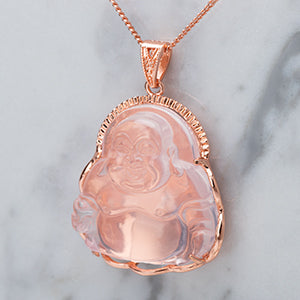What Inspire Jade Culture

Throughout 10,000-years history of developing and using jade, it can be considered that jade culture is deeply influenced by Confucianism, Taoism, and Buddhism. Since ancient times, the Chinese nation has valued morality and righteousness, regardless of whether it is rich or poor, high or low, to regard jade as the representative of Chinese culture, the cornerstone of national culture, the embodiment of sentiment and morality. Wearing a jade Guanyin or jade Buddha, you can pray for the blessing of the gods, and put so many blessings, wishes, and expectations in this exquisite jade pendant.
Avalokitesvara means that as long as all living beings in distress in the world call for help, Avalokitesvara will come to rescue him in time with the sound of Avalokitesvara. Because Guanyin Bodhisattva is so merciful and compassionate and saves all suffering beings, it is called "Great Mercy, Great Compassion, Relief, Suffering, and Distress Guanshiyin Bodhisattva".
Maitreya Buddha, Maitreya is a short transliteration of Sanskrit. It is said that this Buddha often harbors great compassion. He emphasized the need to be generous and tolerant, not to care about the right and wrong in the world.
Jade culture is a very important part in Buddhism, Taoism, and Confucianism.

1. Influenced by Buddhism
The man himself has a combative personality. Guanyin takes compassion as his heart, has a gentle heart and a dignified manner. Wearing Guanyin makes men more peaceful, stable, and less. Fighting and killing, do more good deeds. Maitreya Buddha is compassionate, smiles often, is kind, and optimistic. Women wearing jade Buddhas fully reflect the love of mothers, and at the same time, they can be measured like the big-bellied Buddha, so that women are less jealous and careful, less right and wrong, more tolerant, and measure the vastness like Maitreya Bodhisattva.
2. Influenced by Taoism
The concept of "male wearing Guanyin and female wearing Buddha" in jade wear is also closely related to the balance of yin and yang advocated in my country's Taoism and the Book of Changes. Males belong to yang and females belong to yin; on the contrary, Guanyin means females belong to yin, while Buddhas belong to yang.
Therefore, "males wear Guanyin and females wear Buddhas" can match the wearer's body with yin and yang to achieve the effect of yin and yang balance. From the perspective of traditional Chinese culture, the path of yin and yang is the path of metaplasia of all things in the universe, and the circulation of yin and yang and the sympathy of yin and yang are the inherent nature of the universe's natural endless life and the internal mechanism of the movement of human life. Therefore, whether it is self-cultivation or nourishment, it is necessary to achieve a balance of yin and yang, and then to achieve a state of harmony between body and mind, and the unity of nature and man. This shows that this kind of thinking is also reflected in the culture of jade.
3. Influenced by Confucianism
Confucianism believes that men’s career should be the most important thing in the world. Men wear Guanyin. The homophone of "Guanyin" is the "official seal". This corresponds to the traditional Chinese thoughts of "Feng Hou Hang Seal" and "Promote Officials and Make Money" Senior official, this is also people's good expectation for a prosperous and prosperous career. Women wear "Buddha" in the hope that they can play the role of a good wife and mother, accommodate the tedious things of family life, and often laugh at life. "Buddha" is homonymous with "Fu". Dai Buddha means Dai Fu, which means "blessed for generations", which can bless oneself, family and descendants in harmony and prosperity.
